Duck Breeds With Red Beaks
Ducks come in many different sizes and color patterns. These differing color patterns are not limited to their plumage, either – their bills, legs, and even skin can come in various colors. If you’ve only seen ducks with yellow beaks, you are in for a treat with the bold red beaks of the following ducks.
Which duck breeds have red beaks? The Muscovy is the only domestic duck you are likely to see with a red bill, but there are several exotic ducks with a bright red bill available for purchase through online hatcheries, including the Cape Teal Duck, the Common Shelduck, the Mandarin, the Red Crested Pochard, and the Rosy Billed Pochard.
If you are interested in learning more about red-beaked ducks, read on to learn more about the breeds with these bills, and whether you can add any of these birds to your homestead.
Domestic Ducks With Red Beaks
You will not find many if any, domestic Mallard-derived ducks with red beaks. In the domestic world, yellow and green tend to dominate the duck bills. The Muscovy, however, can be classified as a duck with a red beak.
Muscovy 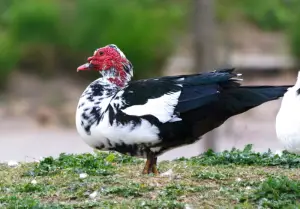
The Muscovy is the only breed of domestic duck that does not share ancestry with the Mallard. Muscovies and Mallards are two different species of duck, with (some) differences in both appearance and behavior.
The most common variety of domestic Muscovy is the White Muscovy. As you can guess, these birds are all-white in color, with red, pink, or sometimes black bills. What really causes the Muscovy to stand out among other breeds of duck is the bird’s caruncles. Caruncles are the fleshy (almost “lumpy”) red layer that surrounds the eyes and face – otherwise known as a “face mask.” Caruncles are also found on turkeys. The bold red of the caruncles adds to the pinkish bills, making them appear bolder and striking against the white of the rest of the duck.
Why do Muscovies have caruncles? No one really knows the purpose behind the caruncles of a Muscovy duck or turkey. There is some evidence that caruncles are larger and fleshier in warmer climates (similar to the larger combs and wattles of a warm-climate chicken), leading to the possibility that the caruncles help with the heat.
Others theorize that the caruncles help to attract the opposite sex. And some believe that it helps keep the duck clean when they are dabbling in muddy water. Perhaps there is a little bit of truth in all of these theories.
Exotic Ducks With Red Beaks
While red beaks are not the norm in domestic ducks, many wild ducks sport red beaks. The below exotic duck breeds are available for purchase from several online hatcheries in the United States – though the purchase price per bird will be significantly higher than the purchase price of any domestic breed (starting at $200-$300 per duck compared to around $6 per Muscovy). While they may not be the most productive in terms of eggs or meat, they are unique and striking for those interested in ornamental ducks or pets.
Cape Teal Duck 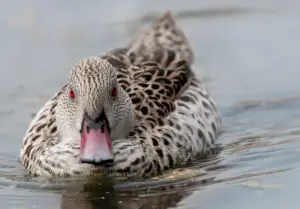
The Cape Teal Duck originates from the wetlands of sub-Saharan Africa. While they are considered dabbling ducks, they are also known to dive similarly to diving ducks. Cape Teals have laced or mottled feather patterns in grays, browns, or fawns. They have red bills (with black trim) and, most striking of all, red eyes. They are docile, easy keepers and breed well in captivity.
Common Shelduck 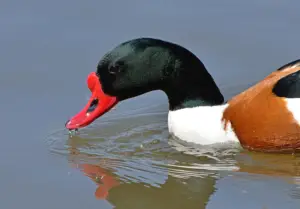
Common Shelducks can be found in a wide range of habitats, from Europe to Asia and Africa.
Common Shelducks are considered large ducks and have been called “half-goose, half-duck” for their frame and attractive appearance. The males are white with large patches of black and rust along the body.
The bill is bright red with a swan-like knob at the top of the base. Females have similar coloring but with less distinct markings and red bills without the dramatic knobs. These birds are popular among exotic duck enthusiasts for their striking appearance and do well in captivity when given ample space. They are successful breeders and typically will mate for life.
Mandarin 
Mandarins originated in China but are more commonly found in captivity today than in the wild. Mandarins are small ducks with brown feathers, though the males will grow striking color patterns at the beginning of each breeding season, complete with long “sail feathers” along the back.
There is a variety of Mandarin that is all-white in plumage, aptly named the White Mandarin, that is also commonly raised in captivity. Both varieties have similarly colored red bills. Mandarins, like Shelducks, tend to mate for life and make excellent parents.
Red Crested Pochard 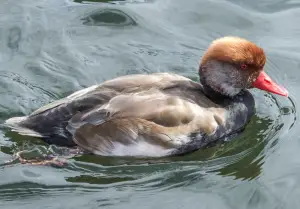
Red Crested Pochard ducks, native to southern Europe, are commonly found both in the wild and in captivity. They are large ducks with fawn-colored bodies, black breasts, red eyes, and bright red bills (females, however, will have black bills). They are most easily recognized for their particularly round heads – giving them a graceful, attractive appearance.
Red Crested Pochards are diving ducks, as opposed to dabblers, and therefore need a body of water of ample size and depth in which to dive and swim. Though they are otherwise easy to raise, this requirement makes them unattainable for those without a pond on the property.
Rosy Billed Pochard 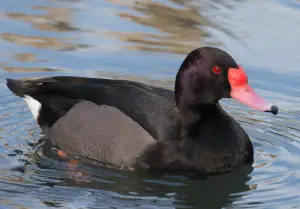
The Rosy Billed Pochard originated in South America and, like the Red Crested, is a diving duck in need of a body of water in which to live. The depth can be shallower than that of the Red Crested Pochard, as Rosy Billed Pochards are content to dabble for their food – though the importance of a permanent body of water is nonetheless significant as these ducks will spend the vast majority of their days and nights in the water.
Also called Rosebills, they are beautiful black birds with light-gray bellies. Their bills are a striking red with a knob at the base. Females have quieter coloring and gray bills. They are not as commonly found in captivity but are dispersed throughout the globe in great numbers.
Domestic vs. Exotic Ducks
If you have your heart set on a duck with a red bill, you will be limited to the Muscovy if shopping for a domestic breed of duck. The benefits of the Muscovy are that they are easy keepers, are quiet and friendly, and are productive in both eggs and meat. If you are in the market for an exotic red-billed duck to keep as a pet or for ornamental purposes, you will have a larger variety to choose from if open to an exotic, wild breed of duck available for sale in many online hatcheries. You will pay a much higher price and will have to take some special precautions with the enclosure, but you will be rewarded every day watching the antics of these truly wild specimens.
What Color Are Duck Beaks?
There are a variety of colors that a duckbill may possess, including yellow, orange, green, red, or even pink. Researchers have discovered that female ducks prefer males with brighter, bolder bills, making beak color a sexually selected trait. The bolder colors can therefore be suggestive of a healthier or stronger duck (one study shows that the sperm of brighter-billed ducks seem to have a better capability of fighting off the bacteria E. coli, for example).
Does A Duck Have A Bill Or A Beak?
You have probably exclusively heard the word “bill” when referring to waterfowl and “beak” when referring to land fowl. It may surprise you, then, to hear that the words can be used interchangeably – they both have the same meaning. In fact, Merriam-Webster defines the word “beak” as “the bill of a bird.” While a beak may look like an extra appendage that extends past the bird’s mouth, it can more accurately be described as the bird’s mouth. A beak is made up of bone and flesh, similar to a human jaw.
Admittedly, though, a duck’s beak looks quite different than a chicken’s beak. Duckbills are designed in such a way that will allow them to scoop and filter. The shape of the bill aids the duck in scooping through the water instead of pecking like a land bird. When it comes to grubs or other hidden snacks, there is a hard ridge at the tip of the bill called a “nail” for digging into the ground.
Duckbills also have a unique feature called lamellae. Lamellae are the flexible fringe that runs along the inside of the bill like teeth – these are used to filter out the water from the food. When the duck uses the bill as a scoop in search of food, there is a need for the water to spill out without allowing the food to escape. This lamellae provides the ability to filter the food from the water.
You can learn more about ducks and other animals in my most recent articles here!
